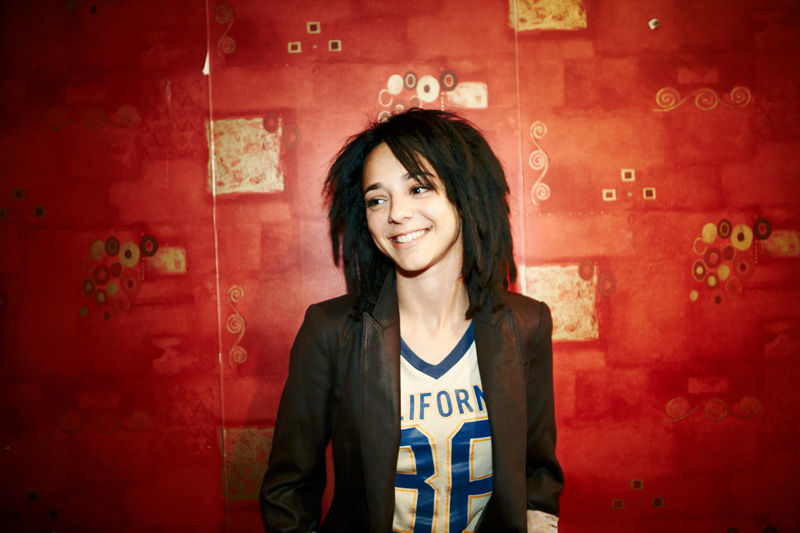Nishmah guest musician brings dynamic spirit to her music, art
Published February 26, 2015
Passover’s over, and wouldn’t it be neat
if you could use all the matzah that you didn’t eat?
1. Catch it like a Frisbee with your friends in the park, or you could
2. jump in the water and pretend you’re a shark
3. You can make a matzah pick and play the guitar, or you can
4. make a matzah license plate for your car
5. Use it as a coaster when you’re drinking your beer or you can…
6. Throw it as confetti for a Happy New Year!
— From “20 Things To Do With Matzah,” Written by Michelle Citrin & William Levin
It’s safe to say that singer/songwriter Michelle Citrin is the only artist on the planet who has had a viral YouTube hit about matzah — more than 1.7 million views — as well as an international dance club hit, “Turn It On.”
The 5-foot 1-inch dreadlocked dynamo tours extensively, telling stories between her folk- and classic rock-inspired original songs. She is also a photographer and an activist who supports women’s causes and a tireless promoter of Jewish culture. Time.com about a year ago included her in a list of top new Jewish music stars, a list headed by St. Louis-based rocker Rick Recht.
Citrin, a native of Fair Lawn, New Jersey, is also a blogger. One post on her website, michellecitrin.com, recounts her experience in summer 2013 praying at the Wall in Jerusalem with a group of women who were confronted by angry, violent, ultra-Orthodox men.
“I had been following the (Women at the Wall) movement, and I always try to see things with my own eyes, just to experience it,” says Citrin, who visits Israel every summer. “An egg whizzed right by my head and fell on the ground right by my feet. I was standing next to my friend’s daughter, and she just looked at it and said, ‘This is so silly, this doesn’t make any sense.’ And I thought this 8-year-old has way more sense than anybody here.”
Citrin, who has performed with artists such as Dave Koz, Matisyahu and Michelle Branch, plans to release her first full-length album, “Left Brained Right Hearted,” this year.
She will perform in St. Louis on Tuesday, March 10, during “The Journey.” The event will mark the 10th anniversary of Nishmah, the St. Louis Jewish Women’s Project.
She called in from her studio in Brooklyn, New York, to talk about the event and her career.
How did you get interested in music?
I was always a musical kid, and I think that for me music and Judaism went kind of hand in hand. Because the way my journey with music began was through my maternal grandmother, who recognized that I had an ear for music. She was a piano player. And she would have me sit with her at the piano, and she would point out note by note how to play some of the songs she was taught by her aunts in Romania.
This grandmother and all of my grandparents are Holocaust survivors, and music was a big part for all of them to connect back to their roots and as a way to pass on their traditions to their families.
Were you raised in an observant home?
I was raised sort of like in an Israeli traditional household. We went to a Conservative synagogue. We went to a Conservative school called the Fair Lawn Jewish Center. … I remember sitting in the synagogue and always feeling like I wanted something more.
As I grew up, going on my journey, I found a place where the worlds collided, around 2004, when I was hired to be a songleader at a camp in California. I had never been a songleader before, and I had never experienced Reform Judaism.
I learned that it is possible to be Jewish
and be musical and have them not be separate entities and parallel lives, but actually to weave them together. That was just a really big turning point for me.
I was amused by the Time.com list of new Jewish music stars. Who knew Time had such a list in the first place?
They missed a bunch (of artists), though. I’m totally flattered, but wow, so many people are doing this work for a very long time. … The beautiful thing is this is my job. I get to play music and offer spiritual guidance to people and lead them in prayer, and it’s amazing. It’s really focusing on spreading positive messages through art and media. It’s just a joy.
I read the lyrics to the matzah song to my mom. She’s 94, she laughed, she loved it.
Oh, my God! To me, that’s the greatest compliment. I get emails about the matzah song from (people from) 8-year-olds to Holocaust survivors. [The elderly] feel such pride that Jewish culture is being celebrated in a public, joyous way. They’ve written letters saying, ‘I never thought I’d see the day that this would happen.’ Imagine. The things that they’ve seen coming from the Holocaust when they had to hide their Jewish identities, and then there’s this thing called YouTube that’s available all over the world, and we can all watch that same video and celebrate. It’s so exciting. I think it’s all about creating culture.
What do you have planned for the St. Louis show?
I’m doing a solo performance to bring about the telling of this incredible journey. We know the story of Passover is from slavery to freedom. We’re going to tell the story from slavery to freedom, we’re going explore our own journey as women. … I’m very excited to be a part of this program. I’ve been a part of the meetings and planning, and this group of women have put together something really powerful, deep and meaningful.















